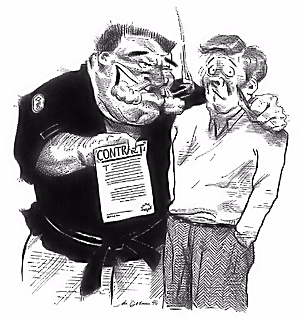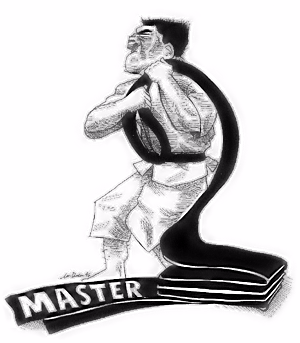
In the four years from 1992 through 1995, Yellow Pages martial art listings in our area have jumped from 98 to 136. This 39 percent increase means that competition for students is stiff. In an effort to increase market share, many instructors resort to what has become an annual event in one-upmanship. The spectacle begins early in November and occurs concurrently in communities across the country. If past performances are any indicator, then this year's show promises to be as sensational as ever. Yes, sports fans, coming soon to homes everywhere: the annual Yellow Pages promotions. Leafing through the recent telephone record and searching the nearly 140 different martial art schools and organizations currently listed in our area, I found no less than one tenth-degree black belt, two ninth-degrees, four eighths, five sevenths, two sixths, and two fifths. (About the only thing missing was ". . . and a partridge in a pear tree".) There are also numerous Masters, Grandmasters, Grand Masters (they're really grand), and the occasional Professor. With so many masters and grandmasters around, some now opt for combination titles like Chief Grand Master, Master-Teacher, and Master Shihan. (If shihan means "master teacher," does master shihan mean "master-master teacher?") Further dividing the master category are American Masters, Certified Masters, and one apparently ultimate, The Master. (Combining these titles is amusing, if not accurate: "THE Certifiable American Master.") All of these with the usual assortment of World Famous and World Champions (small world, huh?). I'll bet you didn't know that our community was so rich in martial talent, now did you? But, there was one blight on those bright yellow pages. Amongst all of these highly credentialed luminaries was one advertisement that had the bare-faced, unmitigated gall to boldly proclaim its chief instructor's rank as a . . . third degree black belt! "Unbelievable," some might say. "This guy says he has trained for nearly thirty years, and yet he is still only a third degree black belt? The guy down the street [just about any street] has been in the martial arts for just ten years, and he is already several degrees above this fellow. What gives?" In fairness, some of the titles listed in the Yellow Pages are legitimate. For example, in some Korean arts, those holding sixth degree black belts and higher are permitted to use the title of "master." Those with an eighth dan and higher may use the title "grandmaster." It must be pointed out that, as one writer noted, grandmaster (as used here) means, for example, a grandmaster in tae kwon do, and not the grandmaster of tae kwon do. That aside, there are still too many self-promotions in the arts (only the self-promoted need write to complain). Anyway, being an area resident since 1964, I have had ample opportunity to follow these annual promotions, and I find it amazing how fast some of these individuals move up in rank. Oh, I'm sure that everyone listed in the phone book can produce a certificate backing up their claimed rank, but too many certificates are, like many of today's black belts, less than what they imply.
I am not faulting anyone for wanting to make a decent living teaching martial arts. I am, however, faulting those who flatly and flagrantly "sell" belts. No wonder so many martial artists – even experienced martial artists – now claim ridiculously high ranks and bloated titles. After giving away or selling black belts to every Tom, Dick, and Harry, about the only way instructors can distinguish themselves from their students is to claim rank that is beyond their own progeny.
I am not saying that a black belt is based solely on physical skill; it is not. Black belt rank stands for much, much more than just the ability to kick and punch. A black belt, even a first degree black belt, must possess more than technical proficiency. He must also possess a maturity greatly exceeding his skill (boy, that disqualifies a lot of us on the spot). A black belt must also have an understanding of the principles employed in his art and be able to pass that knowledge, skill, leadership, and maturity on to others in a precise, clear, and systematic manner. All of these things are what make a "black belt," a black belt. Excess Baggage
The master did, in fact, lose. During the contest my friend was relaxed and generally having a good time. After the match, his students commented on the visiting "master's" obvious frustration and anger over his inability to best their lowly instructor. It amazes me just how heavy excess baggage can be.
How Much is Pride Worth?Say what you like, but I respect this "third degree black belt" with the (now) nearly thirty years of martial art experience. He received his rank the hard way – he earned it. He studied under a hard teacher who had high standards, and a third degree black belt from his instructor really means something. This third degree black belt may never get another degree, but he will continue to learn. His rank – or the lack of it – will never be a hindrance to his growth and, as long as he studies, trains, and grows, he will continue to have an art that is alive, vibrant, and of real value – not in terms of dollars perhaps; but in pride.When I think of masters, a few individuals come to mind. But when they are asked what rank or degree they have, most of them simply reply, "student." Their credentials are often little more than remarks like, "I study with so-and-so right now," (usually someone most of us have never heard of) and "I studied with him (another little known) for so-many years." What should impress us are not ranks and titles, but the fact that real masters are ever students of the art. After decades in the art, these teachers still seek to learn. Teachers like that have no need to proclaim their greatness; their skills do it for them. Epilogue |
|
Footnotes:
|
|
Endnote: If interested, check out an article written some 7 years after this book: Black Belt: What Is It?. |
|
©Copyright Bob Orlando, 1993-2016 All rights reserved. |
http://www.OrlandoKuntao.com
E-mail: ron@orlandokuntao.net |
Last update:
Aug. 6, 2016 by Bob Orlando |




